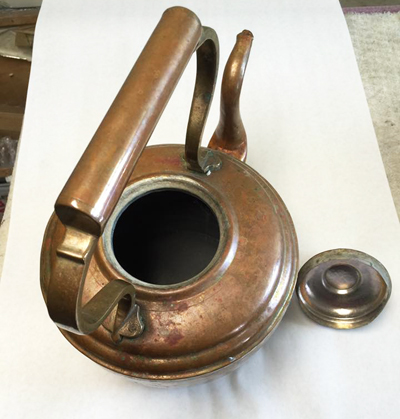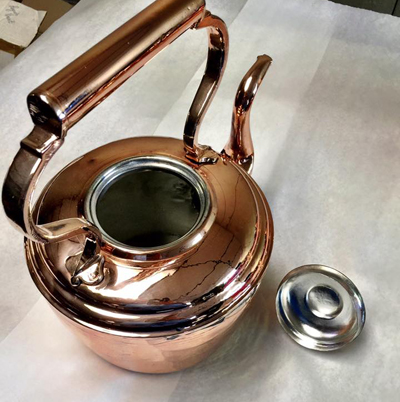Restoring Copper Heirlooms for Future Generations
Copper heirlooms get a second life thanks to Rocky Mountain Retinning, a Denver, CO-based retinning shop dedicated to returning copper artifacts to their original sheen.
Erik Undiks took over Rocky Mountain Retinning last year after working there for 16 years. His father, Peter, started the business in 1975 and still helps with the workload.
And it truly operates under a family business model in that Erik’s mother, wife and brother-in-law also take on different responsibilities across what needs to get done.


To the left is a copper teapot, before retinning. Right, the artifact is restored to its original sheen.
Photographs courtesy of Erik Undiks.
He explains that in the early days, clientele tended to be regional restaurants with equipment like steel mixing bowls which needed to be recoated in tin.
But once they launched a website in 1996, orders began to come from the West Coast to the edge of the Mississippi River, and it involved more copperware of pots, pans and tea kettles.
“We’ve had a sales increase of 10 to 20 percent each year since the website was added,” Undiks says.
Undiks has a Bachelor of Science degree in chemistry from Colorado State University.
Some of the oldest sets of copper kitchenware he has seen are probably about 200 years old, he notes.
“You can see the craftsmanship in those pieces,” he says. “These things have been around for a long time.”
Undiks and his family use the traditional hand-wiping retinning method versus electroplating.
The process involves cleaning, degreasing, acid pickling, heating to the melting point of tin, applying flux to help adhere the metals, wiping the highest grade of molten tin inside, wiping the newest layer clean and polishing.
Since the heat created can be dangerous, Undiks and anyone else who is working on restorations for customers is fully covered with clothing and also wears a respirator and safety glasses.
There’s about a 50/50 split between antique and vintage-era pots, pans, tea kettles and any other kind of copperware which comes in to Rocky Mountain Retinning.
In his industry, Undiks identifies antique as anything from the early 1800s to the 1950s and vintage to mean dating after the 1950s to the 1990s.
“Pieces come in all sorts of ways—sometimes broken apart,” he says.
So cleaning up the copperware is sometimes just part of the restoration work, alongside repairs.
“It’s not something that’s easy to do,” Undiks says, pointing out that all aspects of this work are labor-intensive.
In addition to customers based in the U.S., the niche of this family business has also brought in shipments of orders for restoration from Japan, Australia, New Zealand, France, Italy and Canada.
Approximately 20 percent of his customers are antique dealers or those who are selling copperware online from noticing its demand.
Undiks sees anywhere from two to five boxes of copperware arriving at his shop every day, awaiting retinning and cleanup.
Since questions about proper usage are frequently asked, a pamphlet of tips for copper care goes into each well-packaged box which is shipped back to customers. This also helps customers learn how to make their retinning last longer.
“Around the holidays, our workload doubles,” Undiks says, pointing out that it’s usually because families are giving away heirloom kitchenware as gifts or planning to use copper pots and pans in preparing meals.
Resources:
Also in this Issue:
- The Arizona Copper Museum: Paying Homage to the Country’s Rich Copper Roots
- Shahna Lax: Expressing the Sacred Through Copper
- Restoring Copper Heirlooms for Future Generations
- Mary Button: Turning Paintings into Bronze Relief Sculptures
- Larry Frazier Bronze Works on View at Robert Kuo Gallery
